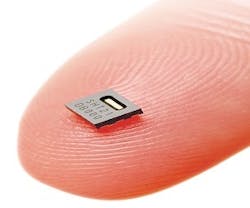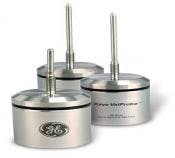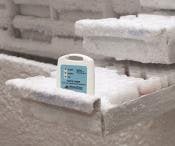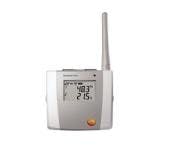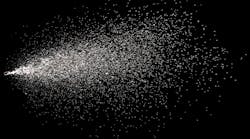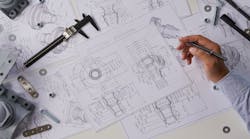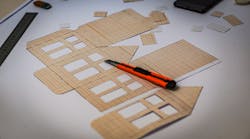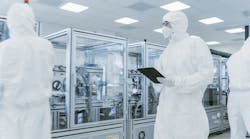As drug manufacturers become more comfortable with wireless technologies, it frees them to centralize their monitoring and control efforts. For general condition monitoring of cleanrooms, labs or processing suites, manufacturers are migrating to systems in which sensors, data loggers, and other devices transmit wirelessly to a central database or web server—often bypassing localized PC’s, workstations, or servers altogether. The ultimate goal is for plant and facility managers to have access to information about room and facility conditions via web browsers, from wherever they may be.
For many years, Planer, PLC (Sunbury, U.K.) has offered hardware and software for measuring temperature, humidity, and other environmental (and processing) parameters around the world. More recently it has shifted its focus from selling specific products to offering those products as part of more comprehensive monitoring solutions, says Ravi Dattani, the company’s export manager. The devices rely more upon wireless technologies, while the software is more Internet-based and accessible remotely (while still 21 CRF Part 11 compliant).
Planer offers what it calls Assure24seven, a web-enabled monitoring and alarm system that allows drug manufacturers to monitor research and process conditions centrally and in real-time. The greatest advantage of such systems, of course, is their alarming capabilities. Key personnel can be alarmed via phone, text, email, and other visual/audible signals should critical conditions arise or equipment drift out of specifications. For Planer’s solution, users can customize their systems so that alerts or alarms can “cascade” depending on severity, the equipment involved, and who needs to be notified. In addition, analysis can be done on each piece of equipment and an item stored in the equipment can be located using sample-tracking software.
An alarm message can be suppressed remotely, Dattani says, though for obvious reasons the system is usually set up by users so that alarm settings or remote operations will not jeopardize workers or the product in the plant nor introduce regulatory risk.
Not everyone in the industry is comfortable going wireless for their monitoring, Dattani says, admitting that wireless systems are not appropriate for all environments. (And Planer also offers hard wired systems.) Wireless technologies can cost a bit more, too, he acknowledges, though their installation is usually simpler and cheaper.
Glenn Adriance, VP of sales and marketing for Mesa Laboratories (Lakewood, Colo.), says that that there’s a comfort level in the drug industry with wireless technologies that was missing in the past. Switching to wireless entails some upfront costs, and of course operators have to alter SOP’s to document that they’re using a different technology, but over the long run it’s the way to go.
Mesa offers different wireless versions of its DataTrace temp, humidity, and pressure data loggers, but those with radiofrequency capability that transmit data in real-time have seen the biggest boost in sales, says Adriance. The interest in the marketplace is coming mainly from those manufacturers who in the past have used wired thermocouple solutions, he says. Mesa has also just signed a distribution agreement with Masy Systems to expand the reach of its DataTrace devices and to take advantage of Masy’s validation services.
Real-time transmissions make sense for those who wish to have up-to-the-minute assurance that their controlled environments are within specs, and be able to get alarm notifications, for example, via a mobile device. Vaisala (Helsinki) has begun offering enhanced alarming services that can notify the right people, immediately, wherever they may be.
Still, Ken Appel, VP of Marketing for Veriteq (Richmond, British Columbia; recently purchased by Vaisala), believes that manufacturers shouldn’t get caught up too much in the wireless hype when it comes to maintaining reliable control of cleanrooms, labs, and other critical environments. Stick with wired applications if possible, Appel says, for reliability and, in many cases, economics. For other applications wireless technologies will show clear benefits, he says, and should then be embraced.
New Product Roundup
What follows is a rundown of new and updated products in the temperature, humidity, and pressure monitoring realm: In March, Vaisala released HUMICAP HMP110, a small, compact temp and humidity probe. The probe covers the full humidity range in temperatures from -40°C to + 80°C. Each individually adjusted probe comes with a NIST-traceable calibration certificate.
Wireless mesh networks claim to give users greater reliability. Comark’s (Hertfordshire, U.K.) new RF500 wireless monitoring system uses mesh for 24/7 temperature monitoring and alarming for processes or entire facilities. The RF500 delivers “virtually 100%” integrity and is tamper-proof, says marketing services manager Alison Butler.
In April, GE Sensing & Inspection Technologies (Billerica, Mass.) introduced an updated version of its Kaye ValProbe validation and monitoring system. Its new Cryo Logger has a broader range (-85°C to +140°C), making it a “single solution” viable for applications such as cryogenic chambers, lyophilizers, and ultralow freezersature range. GE also has a special deal for its old customers: trade in your Kaye or equivalent data logger and get a Cryo Logger in exchange.GE has also just released the Kaye LabWatch Pro, a wired and wireless monitoring system for high-value products. The product’s scalable system architecture suits applications in, for instance, cold chain storage or cell banks where the amount and requirements of products can change. The system has “multi-layered redundancy,” making it extremely reliable for data monitoring and storage, says global product manager Kranthi Tata.
The latest from MadgeTech (Contoocook, N.H.) is the ULT90, an ultra-low temperature freezer validation system. The system aims to provide a complete temperature mapping and validation. For large freezers, for example, the package’s 21 CFR Part 11-compliant software can graph datasets from multiple loggers to show variances in different parts of the freezer, revealing hot spots or air stratifications. The set includes Cryo-Temp data loggers, a USB docking station, software, and IQ/OQ/PQ validation protocols. Cryo-Temps handle temps as low as -86°C, the company says.
Rotronic’s (Hauppauge, N.Y.) new HygroLog NT data logger aims for long-term monitoring applications (e.g., storage and transport) of various parameters. The company says the logger can record and store up to 1.5 million measurement values on a 32-MB flash card, with data downloaded via a card reader, PDA, PC, or docking station. An optional TCP/IP interface can guarantee integration in a network.
REOTEMP’s (San Diego, Calif.) CIP (clean-in-place) Sanitary RTD’s are designed for use in areas with the potential for material contamination, says marketing coordinator Tom Zarcone. The RTD’s have 316 stainless steel wetted parts, conforming to 3A standards. The devices also come with various connection and termination options.
The new ETI from Ellab (Hilleroed, Denmark) is a reference instrument for pharmaceutical processing temperatures, including harsh environments from 32°F to 284°F. The ETI is an alternative to chart recorders, Ellab says, for various reasons: to guarantee accuracy, it has a dual-probe sensor—the primary backed by a redundant sensor. The software saves data in an Excel-friendly computer system validation (CSV) format, and provides for detailed calibration reports.
Testo (Sparta, N.J.) has introduced the 6651 and 6681 transmitters as replacements for inaccurate or older technology and to allow better communication with automation systems as well as on-site calibrationl, says Krys Krawczyk, assistant market manager. The transmitters can be ordered either with a ProfiBus transmission layer or with an Ethernet communication module.
Testo’s transmitters use interchangeable, plug-and-play probes that, along with 21 CFR Part 11 compliant software, are part of theA new exhibitor on the show floor at April’s Interphex show was ShockWatch (Dallas, Texas), which took the occasion to unveil TempMark 8, which handles ascending and descending temperature monitoring during shipment. The system can incorporate multiple pre-programmed alarm conditions, giving users increased data about shipping conditions of vaccines, plasma products, and other drugs. An LCD panel on the device shows what thresholds may have been broken during shipping, and how many times, with an accuracy that is beyond other monitors, says Angela Kerr, shipping and handling product manager.
Finally, Omega Engineering (Stamford, Conn.) recently released the Omega Temperature Measurement Handbook 7th Edition. With 2,000 full-color pages documenting over 40,000 products for process measurement and control—from sanitary temp devices to thermistors to wireless connectors to thermal imagers—the 7th Ed will give you something to read during those precious and few quiet moments in your plant when everything in under control and running like clockwork.
